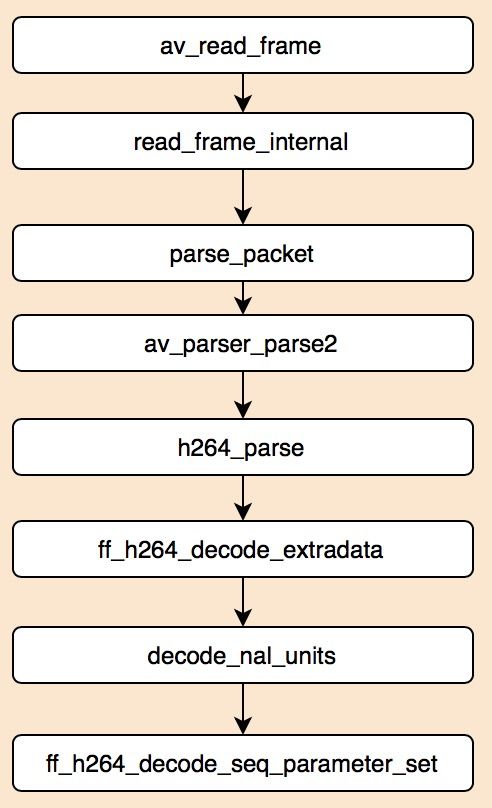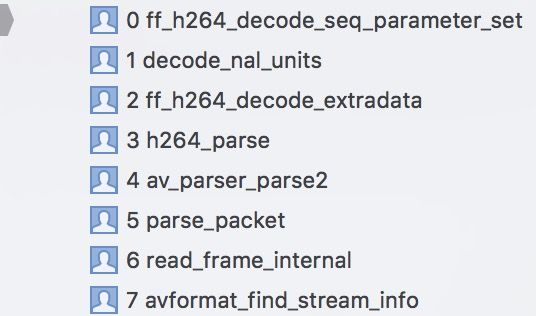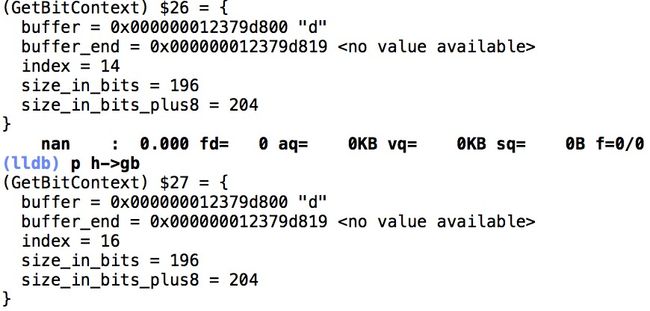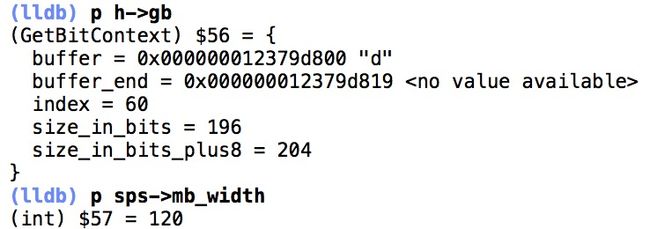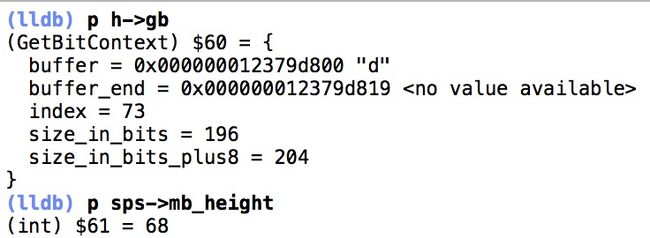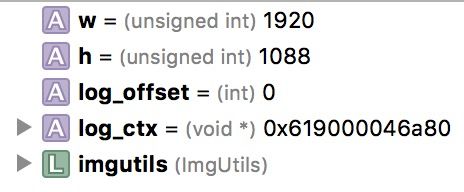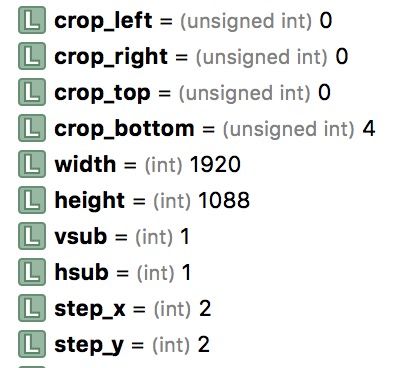版本历史
- 7月29日:新增FFmpeg 3.0源码对SPS的处理分析。
- 7月10日:将2015年12月的代码验证整理成文档。
本文档记录了FFmpeg 3.0源码有关解析H.264(AVC) SPS(Sequence Parameter Set)中处理帧的宽高部分的阅读调试过程,同时对比了ijkplayer解析SPS时遇到的宽高不对问题。
1、FFmpeg 3.0 解析H.264 SPS
FFmpeg 3.0解析SPS的流程如下图所示。
解析SPS的代码如下:
int ff_h264_decode_seq_parameter_set(H264Context *h, int ignore_truncation)
{
int profile_idc, level_idc, constraint_set_flags = 0;
unsigned int sps_id;
int i, log2_max_frame_num_minus4;
SPS *sps;
sps = av_mallocz(sizeof(SPS));
if (!sps)
return AVERROR(ENOMEM);
sps->data_size = h->gb.buffer_end - h->gb.buffer;
if (sps->data_size > sizeof(sps->data)) {
av_log(h->avctx, AV_LOG_WARNING, "Truncating likely oversized SPS\n");
sps->data_size = sizeof(sps->data);
}
memcpy(sps->data, h->gb.buffer, sps->data_size);
profile_idc = get_bits(&h->gb, 8);
constraint_set_flags |= get_bits1(&h->gb) << 0; // constraint_set0_flag
constraint_set_flags |= get_bits1(&h->gb) << 1; // constraint_set1_flag
constraint_set_flags |= get_bits1(&h->gb) << 2; // constraint_set2_flag
constraint_set_flags |= get_bits1(&h->gb) << 3; // constraint_set3_flag
constraint_set_flags |= get_bits1(&h->gb) << 4; // constraint_set4_flag
constraint_set_flags |= get_bits1(&h->gb) << 5; // constraint_set5_flag
skip_bits(&h->gb, 2); // reserved_zero_2bits
level_idc = get_bits(&h->gb, 8);
sps_id = get_ue_golomb_31(&h->gb);
if (sps_id >= MAX_SPS_COUNT) {
av_log(h->avctx, AV_LOG_ERROR, "sps_id %u out of range\n", sps_id);
goto fail;
}
sps->sps_id = sps_id;
sps->time_offset_length = 24;
sps->profile_idc = profile_idc;
sps->constraint_set_flags = constraint_set_flags;
sps->level_idc = level_idc;
sps->full_range = -1;
memset(sps->scaling_matrix4, 16, sizeof(sps->scaling_matrix4));
memset(sps->scaling_matrix8, 16, sizeof(sps->scaling_matrix8));
sps->scaling_matrix_present = 0;
sps->colorspace = 2; //AVCOL_SPC_UNSPECIFIED
if (sps->profile_idc == 100 || // High profile
sps->profile_idc == 110 || // High10 profile
sps->profile_idc == 122 || // High422 profile
sps->profile_idc == 244 || // High444 Predictive profile
sps->profile_idc == 44 || // Cavlc444 profile
sps->profile_idc == 83 || // Scalable Constrained High profile (SVC)
sps->profile_idc == 86 || // Scalable High Intra profile (SVC)
sps->profile_idc == 118 || // Stereo High profile (MVC)
sps->profile_idc == 128 || // Multiview High profile (MVC)
sps->profile_idc == 138 || // Multiview Depth High profile (MVCD)
sps->profile_idc == 144) { // old High444 profile
sps->chroma_format_idc = get_ue_golomb_31(&h->gb);
if (sps->chroma_format_idc > 3U) {
avpriv_request_sample(h->avctx, "chroma_format_idc %u",
sps->chroma_format_idc);
goto fail;
} else if (sps->chroma_format_idc == 3) {
sps->residual_color_transform_flag = get_bits1(&h->gb);
if (sps->residual_color_transform_flag) {
av_log(h->avctx, AV_LOG_ERROR, "separate color planes are not supported\n");
goto fail;
}
}
sps->bit_depth_luma = get_ue_golomb(&h->gb) + 8;
sps->bit_depth_chroma = get_ue_golomb(&h->gb) + 8;
if (sps->bit_depth_chroma != sps->bit_depth_luma) {
avpriv_request_sample(h->avctx,
"Different chroma and luma bit depth");
goto fail;
}
if (sps->bit_depth_luma < 8 || sps->bit_depth_luma > 14 ||
sps->bit_depth_chroma < 8 || sps->bit_depth_chroma > 14) {
av_log(h->avctx, AV_LOG_ERROR, "illegal bit depth value (%d, %d)\n",
sps->bit_depth_luma, sps->bit_depth_chroma);
goto fail;
}
sps->transform_bypass = get_bits1(&h->gb);
decode_scaling_matrices(h, sps, NULL, 1,
sps->scaling_matrix4, sps->scaling_matrix8);
} else {
sps->chroma_format_idc = 1;
sps->bit_depth_luma = 8;
sps->bit_depth_chroma = 8;
}
log2_max_frame_num_minus4 = get_ue_golomb(&h->gb);
if (log2_max_frame_num_minus4 < MIN_LOG2_MAX_FRAME_NUM - 4 ||
log2_max_frame_num_minus4 > MAX_LOG2_MAX_FRAME_NUM - 4) {
av_log(h->avctx, AV_LOG_ERROR,
"log2_max_frame_num_minus4 out of range (0-12): %d\n",
log2_max_frame_num_minus4);
goto fail;
}
sps->log2_max_frame_num = log2_max_frame_num_minus4 + 4;
sps->poc_type = get_ue_golomb_31(&h->gb);
if (sps->poc_type == 0) { // FIXME #define
unsigned t = get_ue_golomb(&h->gb);
if (t>12) {
av_log(h->avctx, AV_LOG_ERROR, "log2_max_poc_lsb (%d) is out of range\n", t);
goto fail;
}
sps->log2_max_poc_lsb = t + 4;
} else if (sps->poc_type == 1) { // FIXME #define
sps->delta_pic_order_always_zero_flag = get_bits1(&h->gb);
sps->offset_for_non_ref_pic = get_se_golomb(&h->gb);
sps->offset_for_top_to_bottom_field = get_se_golomb(&h->gb);
sps->poc_cycle_length = get_ue_golomb(&h->gb);
if ((unsigned)sps->poc_cycle_length >=
FF_ARRAY_ELEMS(sps->offset_for_ref_frame)) {
av_log(h->avctx, AV_LOG_ERROR,
"poc_cycle_length overflow %d\n", sps->poc_cycle_length);
goto fail;
}
for (i = 0; i < sps->poc_cycle_length; i++)
sps->offset_for_ref_frame[i] = get_se_golomb(&h->gb);
} else if (sps->poc_type != 2) {
av_log(h->avctx, AV_LOG_ERROR, "illegal POC type %d\n", sps->poc_type);
goto fail;
}
sps->ref_frame_count = get_ue_golomb_31(&h->gb);
if (h->avctx->codec_tag == MKTAG('S', 'M', 'V', '2'))
sps->ref_frame_count = FFMAX(2, sps->ref_frame_count);
if (sps->ref_frame_count > H264_MAX_PICTURE_COUNT - 2 ||
sps->ref_frame_count > 16U) {
av_log(h->avctx, AV_LOG_ERROR,
"too many reference frames %d\n", sps->ref_frame_count);
goto fail;
}
sps->gaps_in_frame_num_allowed_flag = get_bits1(&h->gb);
sps->mb_width = get_ue_golomb(&h->gb) + 1;
sps->mb_height = get_ue_golomb(&h->gb) + 1;
if ((unsigned)sps->mb_width >= INT_MAX / 16 ||
(unsigned)sps->mb_height >= INT_MAX / 16 ||
av_image_check_size(16 * sps->mb_width,
16 * sps->mb_height, 0, h->avctx)) {
av_log(h->avctx, AV_LOG_ERROR, "mb_width/height overflow\n");
goto fail;
}
sps->frame_mbs_only_flag = get_bits1(&h->gb);
if (!sps->frame_mbs_only_flag)
sps->mb_aff = get_bits1(&h->gb);
else
sps->mb_aff = 0;
sps->direct_8x8_inference_flag = get_bits1(&h->gb);
#ifndef ALLOW_INTERLACE
if (sps->mb_aff)
av_log(h->avctx, AV_LOG_ERROR,
"MBAFF support not included; enable it at compile-time.\n");
#endif
sps->crop = get_bits1(&h->gb);
if (sps->crop) {
unsigned int crop_left = get_ue_golomb(&h->gb);
unsigned int crop_right = get_ue_golomb(&h->gb);
unsigned int crop_top = get_ue_golomb(&h->gb);
unsigned int crop_bottom = get_ue_golomb(&h->gb);
int width = 16 * sps->mb_width;
int height = 16 * sps->mb_height * (2 - sps->frame_mbs_only_flag);
if (h->avctx->flags2 & AV_CODEC_FLAG2_IGNORE_CROP) {
av_log(h->avctx, AV_LOG_DEBUG, "discarding sps cropping, original "
"values are l:%d r:%d t:%d b:%d\n",
crop_left, crop_right, crop_top, crop_bottom);
sps->crop_left =
sps->crop_right =
sps->crop_top =
sps->crop_bottom = 0;
} else {
int vsub = (sps->chroma_format_idc == 1) ? 1 : 0;
int hsub = (sps->chroma_format_idc == 1 ||
sps->chroma_format_idc == 2) ? 1 : 0;
int step_x = 1 << hsub;
int step_y = (2 - sps->frame_mbs_only_flag) << vsub;
if (crop_left & (0x1F >> (sps->bit_depth_luma > 8)) &&
!(h->avctx->flags & AV_CODEC_FLAG_UNALIGNED)) {
crop_left &= ~(0x1F >> (sps->bit_depth_luma > 8));
av_log(h->avctx, AV_LOG_WARNING,
"Reducing left cropping to %d "
"chroma samples to preserve alignment.\n",
crop_left);
}
if (crop_left > (unsigned)INT_MAX / 4 / step_x ||
crop_right > (unsigned)INT_MAX / 4 / step_x ||
crop_top > (unsigned)INT_MAX / 4 / step_y ||
crop_bottom> (unsigned)INT_MAX / 4 / step_y ||
(crop_left + crop_right ) * step_x >= width ||
(crop_top + crop_bottom) * step_y >= height
) {
av_log(h->avctx, AV_LOG_ERROR, "crop values invalid %d %d %d %d / %d %d\n", crop_left, crop_right, crop_top, crop_bottom, width, height);
goto fail;
}
sps->crop_left = crop_left * step_x;
sps->crop_right = crop_right * step_x;
sps->crop_top = crop_top * step_y;
sps->crop_bottom = crop_bottom * step_y;
}
} else {
sps->crop_left =
sps->crop_right =
sps->crop_top =
sps->crop_bottom =
sps->crop = 0;
}
sps->vui_parameters_present_flag = get_bits1(&h->gb);
if (sps->vui_parameters_present_flag) {
int ret = decode_vui_parameters(h, sps);
if (ret < 0)
goto fail;
}
if (get_bits_left(&h->gb) < 0) {
av_log(h->avctx, ignore_truncation ? AV_LOG_WARNING : AV_LOG_ERROR,
"Overread %s by %d bits\n", sps->vui_parameters_present_flag ? "VUI" : "SPS", -get_bits_left(&h->gb));
if (!ignore_truncation)
goto fail;
}
/* if the maximum delay is not stored in the SPS, derive it based on the
* level */
if (!sps->bitstream_restriction_flag) {
sps->num_reorder_frames = MAX_DELAYED_PIC_COUNT - 1;
for (i = 0; i < FF_ARRAY_ELEMS(level_max_dpb_mbs); i++) {
if (level_max_dpb_mbs[i][0] == sps->level_idc) {
sps->num_reorder_frames = FFMIN(level_max_dpb_mbs[i][1] / (sps->mb_width * sps->mb_height),
sps->num_reorder_frames);
break;
}
}
}
if (!sps->sar.den)
sps->sar.den = 1;
if (h->avctx->debug & FF_DEBUG_PICT_INFO) {
static const char csp[4][5] = { "Gray", "420", "422", "444" };
av_log(h->avctx, AV_LOG_DEBUG,
"sps:%u profile:%d/%d poc:%d ref:%d %dx%d %s %s crop:%u/%u/%u/%u %s %s %"PRId32"/%"PRId32" b%d reo:%d\n",
sps_id, sps->profile_idc, sps->level_idc,
sps->poc_type,
sps->ref_frame_count,
sps->mb_width, sps->mb_height,
sps->frame_mbs_only_flag ? "FRM" : (sps->mb_aff ? "MB-AFF" : "PIC-AFF"),
sps->direct_8x8_inference_flag ? "8B8" : "",
sps->crop_left, sps->crop_right,
sps->crop_top, sps->crop_bottom,
sps->vui_parameters_present_flag ? "VUI" : "",
csp[sps->chroma_format_idc],
sps->timing_info_present_flag ? sps->num_units_in_tick : 0,
sps->timing_info_present_flag ? sps->time_scale : 0,
sps->bit_depth_luma,
sps->bitstream_restriction_flag ? sps->num_reorder_frames : -1
);
}
sps->new = 1;
av_free(h->sps_buffers[sps_id]);
h->sps_buffers[sps_id] = sps;
return 0;
fail:
av_free(sps);
return AVERROR_INVALIDDATA;
}
代码分析:
1、skip_bits(&h->gb, 2);跳过两个位,表现为GetBitContext.index后移两个位置。
2、get_ue_golomb_31计算到的sps_id、chroma_format_idc分别是0、1。
3、get_ue_golomb读取亮度、色度的位深度都为8。
4、解析transform_bypass、log2_max_frame_num和poc_type。因poc_type为0,则log2_max_poc_lsb等于get_ue_golomb(&h->gb) + 4。
5、ref_frame_count由get_ue_golomb_31读取为2。
6、读完gaps_in_frame_num_allowed_flag后,sps索引为47。
7、宏块宽度。
8、宏块高度。
9、帧的宽高校对av_image_check_size。
根据编码规则计算到的宽高是1920x1088,而MP4中读取的是1920x1080。那么,如何FFmpeg是如何修正SPS里的宽高计算呢?
实际上,SPS还有crop系列字段,由crop表示帧是否被裁剪、crop_left、crop_right、crop_top和crop_bottom表示要裁剪的值得到正确的宽高值。
sps->crop_left = crop_left * step_x;
sps->crop_right = crop_right * step_x;
sps->crop_top = crop_top * step_y;
sps->crop_bottom = crop_bottom * step_y;
FFmpeg 3.0对SPS的定义如下。
/**
* Sequence parameter set
*/
typedef struct SPS {
unsigned int sps_id;
int profile_idc;
int level_idc;
int chroma_format_idc;
int transform_bypass; ///< qpprime_y_zero_transform_bypass_flag
int log2_max_frame_num; ///< log2_max_frame_num_minus4 + 4
int poc_type; ///< pic_order_cnt_type
int log2_max_poc_lsb; ///< log2_max_pic_order_cnt_lsb_minus4
int delta_pic_order_always_zero_flag;
int offset_for_non_ref_pic;
int offset_for_top_to_bottom_field;
int poc_cycle_length; ///< num_ref_frames_in_pic_order_cnt_cycle
int ref_frame_count; ///< num_ref_frames
int gaps_in_frame_num_allowed_flag;
int mb_width; ///< pic_width_in_mbs_minus1 + 1
int mb_height; ///< pic_height_in_map_units_minus1 + 1
int frame_mbs_only_flag;
int mb_aff; ///< mb_adaptive_frame_field_flag
int direct_8x8_inference_flag;
int crop; ///< frame_cropping_flag
/* those 4 are already in luma samples */
unsigned int crop_left; ///< frame_cropping_rect_left_offset
unsigned int crop_right; ///< frame_cropping_rect_right_offset
unsigned int crop_top; ///< frame_cropping_rect_top_offset
unsigned int crop_bottom; ///< frame_cropping_rect_bottom_offset
int vui_parameters_present_flag;
AVRational sar;
int video_signal_type_present_flag;
int full_range;
int colour_description_present_flag;
enum AVColorPrimaries color_primaries;
enum AVColorTransferCharacteristic color_trc;
enum AVColorSpace colorspace;
int timing_info_present_flag;
uint32_t num_units_in_tick;
uint32_t time_scale;
int fixed_frame_rate_flag;
short offset_for_ref_frame[256]; // FIXME dyn aloc?
int bitstream_restriction_flag;
int num_reorder_frames;
int scaling_matrix_present;
uint8_t scaling_matrix4[6][16];
uint8_t scaling_matrix8[6][64];
int nal_hrd_parameters_present_flag;
int vcl_hrd_parameters_present_flag;
int pic_struct_present_flag;
int time_offset_length;
int cpb_cnt; ///< See H.264 E.1.2
int initial_cpb_removal_delay_length; ///< initial_cpb_removal_delay_length_minus1 + 1
int cpb_removal_delay_length; ///< cpb_removal_delay_length_minus1 + 1
int dpb_output_delay_length; ///< dpb_output_delay_length_minus1 + 1
int bit_depth_luma; ///< bit_depth_luma_minus8 + 8
int bit_depth_chroma; ///< bit_depth_chroma_minus8 + 8
int residual_color_transform_flag; ///< residual_colour_transform_flag
int constraint_set_flags; ///< constraint_set[0-3]_flag
int new; ///< flag to keep track if the decoder context needs re-init due to changed SPS
uint8_t data[4096];
size_t data_size;
} SPS;
2、基于ijkplayer的处理
ijkplayer的计算是错误的,这里写出来只作参考。
avcC数据有41字节,详细数据如下。其中,SPS为26字节:27640028 ... C108。
01640028 FFE1001A 27640028 AD00EC07
80227E5C 05B80808 0A000007 D20001D4
C1080100 0428CE3C B0
按照H.264编码规则:
- 当前SPS的帧的宽 = (sps_info.pic_width_in_mbs_minus1 + 1) * 16
- 当前SPS的帧的高 = (sps_info.pic_height_in_map_units_minus1 + 1) * 16
然而,通过如下代码计算得到的宽高(1888 x 1920)却不完全等同于源视频的宽高(1920 x 1080)。
int width = (int)(sps_info.pic_width_in_mbs_minus1 + 1) << 4;
int height = (int)(sps_info.pic_height_in_map_units_minus1 + 1) << 4;
当再往下读unsigned Exp-Golomb code(nal_bs_read_ue(&bs))且用宽存储当前高(1920)的值,则得到新的高度值1088,显然,这是接近1080这个值的。具体情况是,
sps_info.pic_width_in_mbs_minus1 = 119
sps_info.pic_height_in_map_units_minus1 = 67
那么,对于高度1080的计算是(1080/16.0 - 1) = 67.5 - 1 = 66.5,然而,sps_info.pic_height_in_map_units_minus1类型为uint16_t,显然无法存储66.5,按四舍五入处理,得到67。
解析流程如下:
nal_bitstream bs;
sps_info_struct sps_info = {0};
nal_bs_init(&bs, sps, sps_size);
sps_info.profile_idc = nal_bs_read(&bs, 8);
nal_bs_read(&bs, 1); // constraint_set0_flag
nal_bs_read(&bs, 1); // constraint_set1_flag
nal_bs_read(&bs, 1); // constraint_set2_flag
nal_bs_read(&bs, 1); // constraint_set3_flag
nal_bs_read(&bs, 4); // reserved
sps_info.level_idc = nal_bs_read(&bs, 8);
sps_info.sps_id = nal_bs_read_ue(&bs);
if (sps_info.profile_idc == 100 ||
sps_info.profile_idc == 110 ||
sps_info.profile_idc == 122 ||
sps_info.profile_idc == 244 ||
sps_info.profile_idc == 44 ||
sps_info.profile_idc == 83 ||
sps_info.profile_idc == 86)
{
sps_info.chroma_format_idc = nal_bs_read_ue(&bs);
if (sps_info.chroma_format_idc == 3)
sps_info.separate_colour_plane_flag = nal_bs_read(&bs, 1);
sps_info.bit_depth_luma_minus8 = nal_bs_read_ue(&bs);
sps_info.bit_depth_chroma_minus8 = nal_bs_read_ue(&bs);
sps_info.qpprime_y_zero_transform_bypass_flag = nal_bs_read(&bs, 1);
sps_info.seq_scaling_matrix_present_flag = nal_bs_read (&bs, 1);
if (sps_info.seq_scaling_matrix_present_flag)
{
/* TODO: unfinished */
}
}
sps_info.log2_max_frame_num_minus4 = nal_bs_read_ue(&bs);
if (sps_info.log2_max_frame_num_minus4 > 12) {
// must be between 0 and 12
// don't early return here - the bits we are using (profile/level/interlaced/ref frames)
// might still be valid - let the parser go on and pray.
//return;
}
sps_info.pic_order_cnt_type = nal_bs_read_ue(&bs);
if (sps_info.pic_order_cnt_type == 0) {
sps_info.log2_max_pic_order_cnt_lsb_minus4 = nal_bs_read_ue(&bs);
}
else if (sps_info.pic_order_cnt_type == 1) { // TODO: unfinished
/*
delta_pic_order_always_zero_flag = gst_nal_bs_read (bs, 1);
offset_for_non_ref_pic = gst_nal_bs_read_se (bs);
offset_for_top_to_bottom_field = gst_nal_bs_read_se (bs);
num_ref_frames_in_pic_order_cnt_cycle = gst_nal_bs_read_ue (bs);
for( i = 0; i < num_ref_frames_in_pic_order_cnt_cycle; i++ )
offset_for_ref_frame[i] = gst_nal_bs_read_se (bs);
*/
}
sps_info.max_num_ref_frames = nal_bs_read_ue(&bs);
sps_info.gaps_in_frame_num_value_allowed_flag = nal_bs_read(&bs, 1);
sps_info.pic_width_in_mbs_minus1 = nal_bs_read_ue(&bs);
sps_info.pic_height_in_map_units_minus1 = nal_bs_read_ue(&bs);
// 宽高的计算
int width = (int)(sps_info.pic_width_in_mbs_minus1 + 1) << 4;
int height = (int)(sps_info.pic_height_in_map_units_minus1 + 1) << 4;
ijkplayer的SPS相关操作代码如下所示。
1、定义SPS结体
typedef struct
{
uint64_t profile_idc;
uint64_t level_idc;
uint64_t sps_id;
uint64_t chroma_format_idc;
uint64_t separate_colour_plane_flag;
uint64_t bit_depth_luma_minus8;
uint64_t bit_depth_chroma_minus8;
uint64_t qpprime_y_zero_transform_bypass_flag;
uint64_t seq_scaling_matrix_present_flag;
uint64_t log2_max_frame_num_minus4;
uint64_t pic_order_cnt_type;
uint64_t log2_max_pic_order_cnt_lsb_minus4;
uint64_t max_num_ref_frames;
uint64_t gaps_in_frame_num_value_allowed_flag;
uint64_t pic_width_in_mbs_minus1;
uint64_t pic_height_in_map_units_minus1;
uint64_t frame_mbs_only_flag;
uint64_t mb_adaptive_frame_field_flag;
uint64_t direct_8x8_inference_flag;
uint64_t frame_cropping_flag;
uint64_t frame_crop_left_offset;
uint64_t frame_crop_right_offset;
uint64_t frame_crop_top_offset;
uint64_t frame_crop_bottom_offset;
} sps_info_struct;
2、NAL位流定义
typedef struct
{
const uint8_t *data;
const uint8_t *end;
int head;
uint64_t cache;
} nal_bitstream;
3、NAL位流操作
static void nal_bs_init(nal_bitstream *bs, const uint8_t *data, size_t size)
{
bs->data = data;
bs->end = data + size;
bs->head = 0;
// fill with something other than 0 to detect
// emulation prevention bytes
bs->cache = 0xffffffff;
}
static uint64_t nal_bs_read(nal_bitstream *bs, int n)
{
uint64_t res = 0;
int shift;
if (n == 0)
return res;
// fill up the cache if we need to
while (bs->head < n) {
uint8_t a_byte;
bool check_three_byte;
check_three_byte = true;
next_byte:
if (bs->data >= bs->end) {
// we're at the end, can't produce more than head number of bits
n = bs->head;
break;
}
// get the byte, this can be an emulation_prevention_three_byte that we need
// to ignore.
a_byte = *bs->data++;
if (check_three_byte && a_byte == 0x03 && ((bs->cache & 0xffff) == 0)) {
// next byte goes unconditionally to the cache, even if it's 0x03
check_three_byte = false;
goto next_byte;
}
// shift bytes in cache, moving the head bits of the cache left
bs->cache = (bs->cache << 8) | a_byte;
bs->head += 8;
}
// bring the required bits down and truncate
if ((shift = bs->head - n) > 0)
res = bs->cache >> shift;
else
res = bs->cache;
// mask out required bits
if (n < 32)
res &= (1 << n) - 1;
bs->head = shift;
return res;
}
static bool nal_bs_eos(nal_bitstream *bs)
{
return (bs->data >= bs->end) && (bs->head == 0);
}
// read unsigned Exp-Golomb code
static int64_t nal_bs_read_ue(nal_bitstream *bs)
{
int i = 0;
while (nal_bs_read(bs, 1) == 0 && !nal_bs_eos(bs) && i < 32)
i++;
return ((1 << i) - 1 + nal_bs_read(bs, i));
}
参考:
- IJKPlayer
- FFmpeg 3.0
